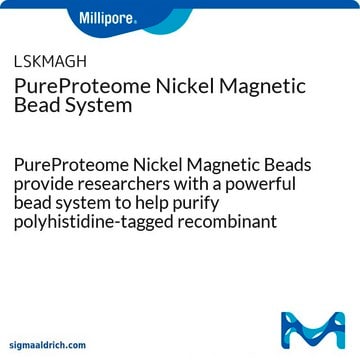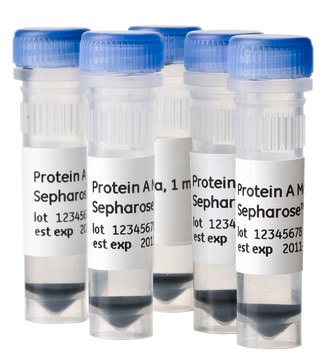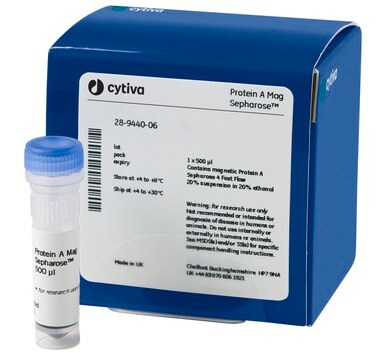LSKMAGA
PureProteome Protein A Magnetic Bead System
The PureProteome Protein A Magnetic Bead System is a powerful system that helps researchers purify proteins by maximizing recovery and eliminating variability
Synonym(s):
Protein A Magnetic Beads
Sign Into View Organizational & Contract Pricing
All Photos(1)
About This Item
UNSPSC Code:
41105507
eCl@ss:
32160405
NACRES:
NA.56
Recommended Products
Quality Level
packaging
pkg of 2 × 1 mL
manufacturer/tradename
PureProteome
technique(s)
depletion: suitable (serum)
immunoprecipitation (IP): suitable
protein purification: suitable
particle size
10 μm
capacity
1.5-2.5 μg/μL, suspension binding capacity (rabbit IgG)
shipped in
wet ice
General description
The PureProteome™ Protein A Magnetic Bead System is a powerful system that helps researchers in protein purification by maximizing recovery and reducing variability.
Application
PureProteome™ Protein A Magnetic Bead System may be used:
- in serum depletion, in immunoprecipitation, for protein purification, and in cell lysates to analyze the bound proteins by western blot
- in magnetic bead-binding assays
- for immunoprecipitating cell lysate and antibodies for ATPase activity
Legal Information
PureProteome is a trademark of Merck KGaA, Darmstadt, Germany
Disclaimer
Unless otherwise stated in our catalog or other company documentation accompanying the product(s), our products are intended for research use only and are not to be used for any other purpose, which includes but is not limited to, unauthorized commercial uses, in vitro diagnostic uses, ex vivo or in vivo therapeutic uses or any type of consumption or application to humans or animals.
Storage Class Code
12 - Non Combustible Liquids
WGK
nwg
Flash Point(F)
Not applicable
Flash Point(C)
Not applicable
Certificates of Analysis (COA)
Search for Certificates of Analysis (COA) by entering the products Lot/Batch Number. Lot and Batch Numbers can be found on a product’s label following the words ‘Lot’ or ‘Batch’.
Already Own This Product?
Find documentation for the products that you have recently purchased in the Document Library.
Customers Also Viewed
Kris Wilson et al.
Journal of biomolecular screening, 20(2), 292-298 (2014-10-10)
Human kynurenine 3-monooxygenase (KMO) is emerging as an important drug target enzyme in a number of inflammatory and neurodegenerative disease states. Recombinant protein production of KMO, and therefore discovery of KMO ligands, is challenging due to a large membrane targeting
Konstantin Chegaev et al.
ACS medicinal chemistry letters, 8(3), 361-365 (2017-03-25)
Nitric oxide (NO) release from a suitable NO photodonor (NOP) can be fine-tuned by visible light stimuli at doses that are not toxic to cells but that inhibit several efflux pumps; these are mainly responsible for the multidrug resistance of
Fei-Yun Chen et al.
The Journal of cell biology, 218(9), 3002-3018 (2019-08-08)
The BH3-only pro-apoptotic protein BIK is regulated by the ubiquitin-proteasome system. However, the mechanism of this regulation and its physiological functions remain elusive. Here, we identify Cul5-ASB11 as the E3 ligase targeting BIK for ubiquitination and degradation. ER stress leads
Holger Laux et al.
Biotechnology and bioengineering, 115(10), 2530-2540 (2018-05-20)
An increasing number of nonantibody format proteins are entering clinical development. However, one of the major hurdles for the production of nonantibody glycoproteins is host cell-related proteolytic degradation, which can drastically impact developability and timelines of pipeline projects. Chinese hamster
Thibaut Hacquard et al.
Cell reports, 39(2), 110671-110671 (2022-04-14)
RNA silencing is a conserved mechanism in eukaryotes involved in development and defense against viruses. In plants, ARGONAUTE1 (AGO1) protein plays a central role in both microRNA- and small interfering RNA-directed silencing, and its expression is regulated at multiple levels.
Our team of scientists has experience in all areas of research including Life Science, Material Science, Chemical Synthesis, Chromatography, Analytical and many others.
Contact Technical Service












